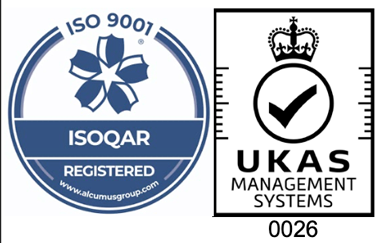Uses of Rubber in the Aerospace Industry
4th September, 2025
The aerospace industry consists of aircraft and aviation, spacecraft and military and defence, and added £42.2 billion to the UK economy in 2024. Rubber plays an essential role in the aerospace industry because of its many properties, including flexibility, strength and durability in extreme conditions.
Although new technologies and innovations are emerging throughout the aerospace industry, and with current trends in the rubber industry constantly evolving, rubber has been a critical material in the sector for many years and its prominence continues today.
This guide to the uses of rubber in the aerospace industry will explore each sector and where rubber is used, why rubber is so important, the materials used in the industry and how to maintain and preserve them.
What is the aerospace industry?
The aerospace industry encompasses the design, development, production, operation and maintenance of aircraft, including passenger and military aircraft, and spacecraft.
In the UK, the aerospace sector is at the cutting edge of transport innovation. There are a range of companies who are heavily associated and involved with the aerospace industry, with bases in the UK. Rolls Royce are responsible for engine technology – focusing on civil aerospace engines – at their base in Derby, whilst Airbus and Boeing oversee commercial and military aircraft operations.
Airbus designs and manufactures modern and fuel-efficient airliners in commercial aircraft whilst in helicopters, Airbus provides civil and military rotorcraft solutions. They are also a European leader in space systems, defence and security. Meanwhile, Boeing design, manufacture and sell aeroplanes, rotorcraft, rockets and satellites worldwide, and the company has a presence across 30 locations in the UK, including London Gatwick Airport and RAF Lossiemouth.
During the design and manufacture of any aircraft, these companies must consider the use and integration of rubber into these aircraft systems. At Aquaseal Rubber, we can provide bespoke rubber solutions for any project, including aerospace applications.
Where is rubber used in the aerospace industry?
Rubber is used across various applications in the aerospace industry, from commercial airlines that travel across the globe and rockets which take trips to space to defence aircraft used by the military.
Aviation and Aircraft
Rubber is used in aircraft design and maintenance to maximise the safety of the aeroplane and comfort of passengers in the following areas:
- Rubber seals: used to maintain cabin pressure, prevent leaks in windows, doors and hatches, and seal gaps around important instruments and controls in the cockpit, rubber seals are invaluable in aviation.
- Mounts and pads: used to absorb vibrations from engines and other aircraft systems, rubber mounts and bespoke rubber pads improve comfort and protect sensitive equipment.
- Tyres: made of conductive rubber, usually containing silicone, aeroplane tyres use rubber to dissipate the static electricity generated during take off and landing.
- Fuel and hydraulic systems: rubber seals and rubber gaskets are used to prevent leaks in fuel and hydraulic systems to ensure safe and reliable operation.
- Environmental protection: rubber is used in wire harnesses and other components to protect them from exposure to abrasion, heat and chemicals.
- Engine system components: since the engine of an aeroplane will face high temperatures, pressures and use, rubber is used in engine gaskets to withstand this.
Spacecraft
In spacecraft, like rockets and satellites, rubber is vital for maintaining pressure and temperature, and protecting sensitive electronics from the harsh atmosphere in space. They are used for:
- Sealing: airtight, fluid and electronic compartment seals are crucial parts of spacecraft systems which use rubber seals or rubber gaskets. Airtight rubber seals are used to maintain a pressurised and breathable environment, especially in hatch, window and door seals. Fluid seals prevent leaks in fuel lines and hydraulic systems, whilst rubber seals are used to seal sensitive electronic components.
- Insulation: rubber is used in thermal blankets to regulate temperature and protect the spacecraft and its occupants from extreme heat and cold, and it is also used to insulate wires and electrical components, preventing short circuits and ensuring the spacecraft’s electrical systems operate safely.
- Vibration dampening: rubber is used to isolate vibrations and decrease noise levels to protect delicate instruments and equipment from the intense vibrations experienced during launch and in orbit, and is also incorporated into mechanical damping systems to reduce these vibrations and other shocks.
Other uses of rubber in spacecraft include fuel-feed lines to ensure there are no fuel leaks, in membranes to store fluids and gases, and rubber coatings which are applied to textiles to prevent against abrasion and chemicals.
Military and Defence
In the military and defence sector of the aerospace industry, rubber is used in protective clothing, vehicle components and other specialised applications. Not only does equipment used in the military and defence sector need to perform optimally, but it also needs to protect people and rubber is used to do this in the following:
- Protective clothing: rubber is used in gloves, boots, helmets and body armour to provide resistance to impact, puncture, chemical exposure and extreme temperatures.
- Fluid transfer and containment: since military aircraft, including aeroplanes and helicopters, can be used to transfer fluids such as oil, fuel and hydraulic fluids, rubber hoses and tubing are used to safely transfer these fluids.
- Seals, gaskets and vibration dampening: similarly to commercial aircraft and spacecraft, the military and defence sector uses rubber seals and rubber gaskets to prevent leaks and improve performance, and rubber pads are used to reduce vibration and shock which enhances stability, minimises noise and protects electronic systems.
What rubber materials are used in the aerospace industry?
Rubber has a range of unique properties – from flexibility and strength to temperature and chemical resistance – meaning it is the most suitable choice of use in the aerospace industry. Since aerospace operations need suitable sealing solutions, insulation and vibration protection, rubber plays an essential role in the industry by enhancing safety and comfort whilst optimising performance.
To ensure all the needs are met to the highest standard, there are a range of rubber materials which can be used in the aerospace industry, depending on the custom need of particular applications. These include:
- Neoprene: one of the common rubber materials used in the aerospace industry, neoprene rubber offers good resilience when exposed to ozone, oil and water. It also has a wide operating temperature range from -40°C to 100°C, but it is not recommended for applications including brake fluids.
- EPDM: with resistance to weather conditions, diester lubricants and petroleum oils, Ethylene Propylene Diene Monomer is known for its durability and longevity, meaning it provides excellent resistance to wear and tear.
- Silicone: with a maximum operating temperature of 250°C, silicone is an exceptional choice for the aerospace industry, especially in aircraft tyres. With excellent tensile and tear strength, silicone is a great rubber material for the aerospace industry.
What are the best ways to maintain rubber in the aerospace industry?
Looking after any rubber product is a crucial part of expanding its lifespan and optimising performance. In the aerospace industry, where precision and safety are both paramount, it is absolutely essential to properly maintain rubber products.
Caring for rubber can be completed by:
- Conducting regular visual inspections for signs of wear, cracking, swelling or degradation.
- Using appropriate cleaning agents and methods to remove dirt, damage and contaminants whilst avoiding harsh chemicals that could cause damage.
- Implementing relevant protective measures, like using other protectant products to shield rubber from UV, weather and chemicals which could cause fading, cracking, softening and degradation.
- Ensuring rubber is replaced as soon as issues arise since this causes rubber to deteriorate over time, leading to reduced performance and even potential failure if ignored.
How Aquaseal Rubber can support your application in the aerospace industry
At Aquaseal Rubber, we understand the importance of bespoke rubber solutions based on individual projects and applications. We are proud to support clients worldwide on a range of custom projects.
If you are looking for new rubber products to support an aerospace industry project, our team are here to help. Contact us today to see how we can work together.


